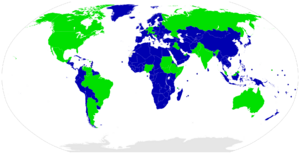Unitary state: Difference between revisions
robertparr (talk | contribs) No edit summary |
No edit summary |
||
| (5 intermediate revisions by 2 users not shown) | |||
| Line 1: | Line 1: | ||
[[File:Map of unitary and federal states.svg.png|thumb|[[File:Blue small.png|frameless]] Unitary states<br>[[File:Green.png|frameless]] Federal states]] | [[File:Map of unitary and federal states.svg.png|thumb|[[File:Blue small.png|frameless]] Unitary states in the real world<br>[[File:Green.png|frameless]] Federal states in the real world]] | ||
A '''unitary state''' is a sovereign state governed as a single entity in which the central government is the supreme authority. The central government may create (or abolish) administrative divisions (sub-national units). Such units exercise only the powers that the central government chooses to delegate. Although political power may be delegated through devolution to regional or local governments by statute, the central government may abrogate the acts of devolved governments or curtail (or expand) their powers. | A '''unitary state''' is a sovereign state governed as a single entity in which the central government is the supreme authority. The central government may create (or abolish) administrative divisions (sub-national units). Such units exercise only the powers that the central government chooses to delegate. Although political power may be delegated through devolution to regional or local governments by statute, the central government may abrogate the acts of devolved governments or curtail (or expand) their powers. | ||
IUnitary states stand in contrast to federations, also known as ''[[Mega-nation|federal states]]''. In real life, a large majority of the world's sovereign states (166 of the 193 UN member states) have a unitary system of government. However, on EarthMC, a large amount of nations are instead meganations, or federal states, however unitary states still outnumber federal ones. | |||
== Devolution compared with federalism == | == Devolution compared with federalism == | ||
A unitary system of government can be considered to be the opposite of federalism. In federations, the provincial/regional governments share powers with the central government as equal actors through a written constitution | A unitary system of government can be considered to be the opposite of federalism. In federations, or mega-nations, the provincial/regional/state governments share powers with the central government as equal actors through a written or unwritten constitution in which both play a part. This means that the sub-national units have a right to existence and powers that cannot be unilaterally changed by the central government. | ||
[[File:The pathway of regional integration or separation.png|center|thumb|700x700px]] | |||
[[File:The pathway of regional integration or separation.png|center|thumb]] | |||
Latest revision as of 01:08, 26 July 2023
A unitary state is a sovereign state governed as a single entity in which the central government is the supreme authority. The central government may create (or abolish) administrative divisions (sub-national units). Such units exercise only the powers that the central government chooses to delegate. Although political power may be delegated through devolution to regional or local governments by statute, the central government may abrogate the acts of devolved governments or curtail (or expand) their powers.
IUnitary states stand in contrast to federations, also known as federal states. In real life, a large majority of the world's sovereign states (166 of the 193 UN member states) have a unitary system of government. However, on EarthMC, a large amount of nations are instead meganations, or federal states, however unitary states still outnumber federal ones.
Devolution compared with federalism
A unitary system of government can be considered to be the opposite of federalism. In federations, or mega-nations, the provincial/regional/state governments share powers with the central government as equal actors through a written or unwritten constitution in which both play a part. This means that the sub-national units have a right to existence and powers that cannot be unilaterally changed by the central government.

